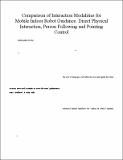Por favor, use este identificador para citar o enlazar a este item:
http://hdl.handle.net/10261/133081COMPARTIR / EXPORTAR:
 SHARE SHARE
 CORE
BASE CORE
BASE
|
|
| Visualizar otros formatos: MARC | Dublin Core | RDF | ORE | MODS | METS | DIDL | DATACITE | |

| Título: | Comparison of interaction modalities for mobile indoor robot guidance: Direct physical interaction, person following, and pointing control |
Autor: | Jevtić, Aleksandar; Doisy, Guillaume; Parmet, Yisrael; Edan, Yael | Fecha de publicación: | 2015 | Editor: | Institute of Electrical and Electronics Engineers | Citación: | IEEE Transactions on Human-Machine Systems 45(6): 653-663 (2015) | Resumen: | Three advanced natural interaction modalities for mobile robot guidance in an indoor environment were developed and compared using two tasks and quantitative metrics to measure performance and workload. The first interaction modality is based on direct physical interaction requiring the human user to push the robot in order to displace it. The second and third interaction modalities exploit a 3-D vision-based human-skeleton tracking allowing the user to guide the robot by either walking in front of it or by pointing toward a desired location. In the first task, the participants were asked to guide the robot between different rooms in a simulated physical apartment requiring rough movement of the robot through designated areas. The second task evaluated robot guidance in the same environment through a set of waypoints, which required accurate movements. The three interaction modalities were implemented on a generic differential drive mobile platform equipped with a pan-tilt system and a Kinect camera. Task completion time and accuracy were used as metrics to assess the users' performance, while the NASA-TLX questionnaire was used to evaluate the users' workload. A study with 24 participants indicated that choice of interaction modality had significant effect on completion time (F(2,61) = 84.874, p < 0.001), accuracy (F(2,29) = 4.937, p = 0.016), and workload (F(2,68) = 11.948, p < 0.001). The direct physical interaction required less time, provided more accuracy and less workload than the two contactless interaction modalities. Between the two contactless interaction modalities, the person-following interaction modality was systematically better than the pointing-control one: The participants completed the tasks faster with less workload. | Versión del editor: | http://dx.doi.org/10.1109/THMS.2015.2461683 | URI: | http://hdl.handle.net/10261/133081 | DOI: | 10.1109/THMS.2015.2461683 | Identificadores: | doi: 10.1109/THMS.2015.2461683 issn: 2168-2305 e-issn: 2168-2291 |
| Aparece en las colecciones: | (IRII) Artículos |
Ficheros en este ítem:
| Fichero | Descripción | Tamaño | Formato | |
|---|---|---|---|---|
| pointing-control.pdf | 977,66 kB | Adobe PDF |  Visualizar/Abrir |
CORE Recommender
SCOPUSTM
Citations
46
checked on 16-abr-2024
WEB OF SCIENCETM
Citations
40
checked on 24-feb-2024
Page view(s)
230
checked on 18-abr-2024
Download(s)
393
checked on 18-abr-2024
Google ScholarTM
Check
Altmetric
Altmetric
NOTA: Los ítems de Digital.CSIC están protegidos por copyright, con todos los derechos reservados, a menos que se indique lo contrario.
